

Creation myths. Creation. Creation Myths. Shillluk (Africa) [Excerpted and edited from Folklore in the Old Testament, J.G.
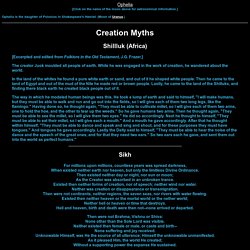
Frazer.] ENUMA ELISH. Sacred-Texts Ancient Near East.
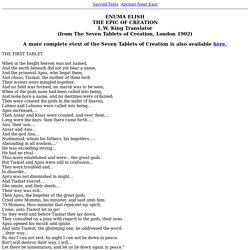
Epic of Creation. Epic of Creation (Mesopotamia) Stories describing creation are prominent in many cultures of the world.
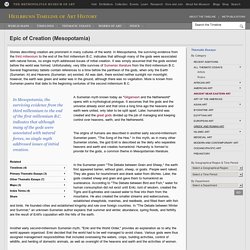
In Mesopotamia, the surviving evidence from the third millennium to the end of the first millennium B.C. indicates that although many of the gods were associated with natural forces, no single myth addressed issues of initial creation. It was simply assumed that the gods existed before the world was formed. Unfortunately, very little survives of Sumerian literature from the third millennium B.C. Comparison of Four African Creation Myths. By Jill Stuckwisch. The Epic of Gilgamesh: Character List. Genesis creation narrative. The Genesis creation narrative is the creation myth of both Judaism and Christianity.

It is made up of two parts, roughly equivalent to the first two chapters of the Book of Genesis. In the first part, Genesis 1:1 through Genesis 2:3, Elohim, the generic Hebrew word for God, creates the world in six days, then rests on, blesses and sanctifies the seventh day. God creates by spoken command ("Let there be... "), suggesting a comparison with a king, who has only to speak for things to happen,[2] and names the elements of the cosmos as he creates them, in keeping with the common ancient concept that things did not really exist until they had been named.
Composition[edit] Sources[edit] Although tradition attributes Genesis to Moses, some biblical scholars believe that it, together with the following four books (making up what Jews call the Torah and biblical scholars call the Pentateuch) is "a composite work, the product of many hands and periods. " Framework interpretation (Genesis) This article focuses on the views of certain Christian commentators and theologians.
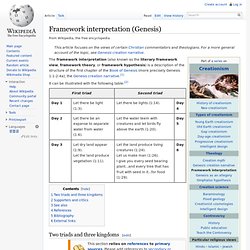
For a more general account of the topic, see Genesis creation narrative. The framework interpretation (also known as the literary framework view, framework theory, or framework hypothesis) is a description of the structure of the first chapter of the Book of Genesis (more precisely Genesis 1:1-2:4a), the Genesis creation narrative. It can be illustrated with the following table: Allegorical interpretations of Genesis. Genesis is part of the canonical scriptures for both Christianity and Judaism, and thus to believers is taken as being of spiritual significance.
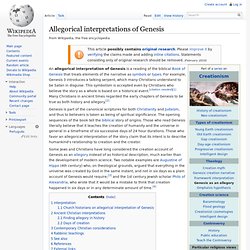
Salvation. Salvation (Latin salvatio; Greek sōtēria; Hebrew yeshu'ah) is being saved or protected from harm[1] or being saved or delivered from some dire situation.[2] In religion, salvation is stated as the saving of the soul from sin and its consequences.[3]

Original sin. Ancestral sin. Ancestral sin (Greek: προπατορικὴ ἁμαρτία or προπατορικὸν ἁμάρτημα, more rarely προγονικὴ ἁμαρτία) is the object of a Christian doctrine taught by the Eastern Orthodox Church.
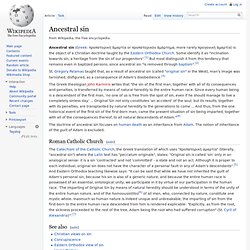
Some identify it as "inclination towards sin, a heritage from the sin of our progenitors".[1] But most distinguish it from this tendency that remains even in baptized persons, since ancestral sin "is removed through baptism".[2] St. Gregory Palamas taught that, as a result of ancestral sin (called "original sin" in the West), man's image was tarnished, disfigured, as a consequence of Adam's disobedience.[3] Creator deity. Polytheism[edit] Platonic demiurge[edit] Monolatrism[edit] Monism[edit] Monism has its origin in Hellenistic philosophy as a concept of all things deriving from a single substance or being.
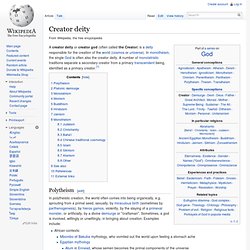
Following a long and still current tradition H.P. "Pantheists are ‘monists’...they believe that there is only one Being, and that all other forms of reality are either modes (or appearances) of it or identical with it. " Although, like Baruch Spinoza, some pantheists may also be monists, and monism may even be essential to some versions of pantheism (like Spinoza's), not all pantheists are monists. Creation of man from clay. Fashioning a man out of clay According to Genesis 2:7 "And the Lord God formed man of the dust of the ground, and breathed into his nostrils the breath of life; and man became a living soul.
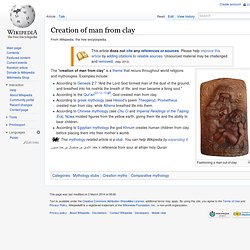
"According to the Qur'an[23:12–15], God created man from clay.According to greek mythology (see Hesiod's poem Theogeny), Prometheus created man from clay, while Athena breathed life into them.According to Chinese mythology (see Chu Ci and Imperial Readings of the Taiping Era), Nüwa molded figures from the yellow earth, giving them life and the ability to bear children.According to Egyptian mythology the god Khnum creates human children from clay before placing them into their mother's womb. انا خلقنا الانسان من صلصال من حمإ مسنون reference from sour at alhijer holy Quran. Young Earth creationism. Old Earth creationism. Old Earth creationism is an umbrella term for a number of types of creationism, including gap creationism, progressive creationism, and evolutionary creationism.[1] Old Earth creationism is typically more compatible with mainstream scientific thought on the issues of physics, chemistry, geology and the age of the Earth, in comparison to young Earth creationism.[2] Types of old Earth creationism[edit] Gap creationism[edit] Gap creationism states that life was immediately and recently created on a pre-existing old Earth.
One variant rests on a rendering of Genesis 1:1-2 as: Second death. The second death is an eschatological concept in Judaism and Christianity related to punishment after a first, natural, death. Judaism[edit] Afterlife. Ancient Egyptian papyrus depicting the journey into the afterlife. Paradise of Bhaishajyaguru discovered at the Mogao Caves. [edit] In metaphysical models, theists generally believe some sort of afterlife awaits people when they die. Members of some generally non-theistic religions such as Buddhism, tend to believe in an afterlife, but without reference to a God. The Sadducees were an ancient Jewish sect that generally believed that there was a God but no afterlife. Many religions, whether they believe in the soul's existence in another world like Christianity, Islam and many pagan belief systems, or in reincarnation like many forms of Hinduism and Buddhism, believe that one's status in the afterlife is a reward or punishment for their conduct during life.
Reincarnation[edit] Temptation. More informally, temptation may be used to mean "the state of being attracted and enticed" without anything to do with moral, ethical, or ideological valuation; for example, one may say that a piece of food looks "tempting" even though eating it would result in no negative consequences. Religious usage[edit] Temptation has implications deeply rooted in Judaism and the The Old Testament, starting with the story of Eve and the original sin. Many non-Western cultures had no precise equivalent until coming into contact with Europeans. [citation needed] For example, Jesuit missionaries in Brazil, translating the Lord's Prayer into Old Tupi, had to use the Portuguese word tentação, since Tupi had no word expressing "temptation" in that sense (see Old Tupi language#Sample text).
[citation needed] Serpent (Bible) Tree of the knowledge of good and evil. Garden of Eden.